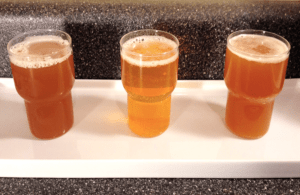 One of the hardest parts of homebrewing is the waiting – especially after the beer has been bottled or kegged. But this is an important time for the beer. You could call it a “self discovery” phase. Brewers call it conditioning.
One of the hardest parts of homebrewing is the waiting – especially after the beer has been bottled or kegged. But this is an important time for the beer. You could call it a “self discovery” phase. Brewers call it conditioning.
About Conditioning
Conditioning is an important phase of the brewing process. Commercial breweries typically employ both a warm and a cold conditioning period. This can be compared to homebrewers doing both a secondary fermentation (warm, at normal fermenting temperatures), followed by a cold conditioning phase (“cold crashing” or lagering). These two phases can be applied to both ales and lagers.
So what happens during the conditioning phase?
A few things:
- The final stages of fermentation, where the last remaining sugars are converted to alcohol and CO2
- Yeast “cleans up” the beer by reducing certain flavor compounds (see diacetyl), and continues to do so after bottling/kegging (less so if the beer has been filtered)
- Settling of various compounds (proteins, yeast, etc.) to aid in beer clarity.
While the beer is still conditioning, it is often referred to as “green beer”.
So back to the Flower Power clone and my struggle with patience…
I was curious to see how the beer is progressing, so I did a taste test with the kegged beer, the bottled beer, and the original Flower Power. I was especially antsy because people always says that IPAs be enjoyed fresh (e.g. Stone’s “Enjoy By” IPA). But how fresh is too fresh? At what point does an IPA reach its peak?
The trouble with this line of thinking is that there are just too many variables at play to develop a hard and fast rule. Among the many variations that can affect flavor perception include:
- hop varieties
- hop quantities
 malt variety
malt variety- original gravity
- final gravity
- water source
- yeast selection
- yeast pitch rate
- fermentation temperature
- yeast flocculation
- kegged or bottle conditioned
- age
Not to mention variations in the brewing process. So with the knowledge that this experiment is inherently flawed, let’s see what we have.
Appearance
The most remarkable difference between the three beers is the clarity. Not surprisingly, the original Flower Power is much clearer than the clones. That’s a commercial beer and it’s probably filtered. Interestingly, the kegged beer is much murkier than the bottled beer, making it appear quite a bit darker than the original Flower Power. This makes sense because when beer is served from the keg, it’s served from the bottom, where all the yeast and whatnot settles. Bottles, on the other hand, are served from the top, away from all the sediment. Given enough time, I suspect that the kegged beer should meet or surpass the bottled beer in clarity, and when that happens, the color should more closely resemble the original Flower Power.
Aroma
The Flower Power exhibits more sweet orange hop aroma, while the clone has more of a grapefruit and pine character. Interestingly, the bottled clone seems to offer slightly more malt aroma.
Flavor
Because the original Flower Power has had significantly more time to age (bottles were purchased four months ago) it’s hard to make comparisons. Still, the weeks and months that go by don’t seem to diminish the hop character in the Flower Power. With the clones, the flavor profile is remarkably similar to the original, but it’s obvious that they need more time to condition. The bitterness is slightly harsh and I detect a slight solvent/alcoholic character. While it’s tempting to overthink the situation and try to identify potential faults, I’m going to do my best to “Relax, don’t worry, have a homebrew,” just like Charlie Papazian likes to say, and give the beer more time to condition.
So, we’ll give the Flower Power clone another week or two and then do another side-by-side. Until then, I’ll be enjoying my Captain Cogsworth Coffee Stout!
—————————————————————–
Review the whole Flower Power clone brewing process below:
- Part 1: Developing a Recipe
- Part 2: Brewing Water Adjustments
- Part 3: Brew Day
- Part 4: Primary Fermentation Mishaps
- Part 5: Bottling & Kegging
- Part 6: A Conditioning Taste Test
- Part 7: Final Side-by-Side and Recipe Edits
—————————————————————–
David Ackley is a beer writer, homebrewer, and self-described “craft beer crusader.” He holds a General Certificate in Brewing from the Institute of Brewing and Distilling and is founder of the Local Beer Blog.

I remember back many moons ago when I made my first batch. Being a rookie brewer I worried about everything. After I got the ale bottled I was concerned about how the carbonation was going. After nine days I chilled a bottle to try and it was pretty flat, but had a little fizz. I let it go the full two weeks and tried another. Very nice carbonation, but the stuff tasted awful. I was totally bummed out. I almost decided to give up brewing after that first batch. The cases sat in the basement for a few weeks and I was thinking about dumping them, but I figured that I would taste it once more. It was wonderful!!!!!! What a difference a few weeks conditioning makes,